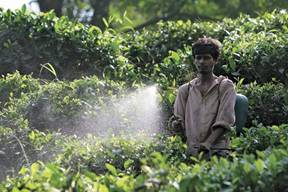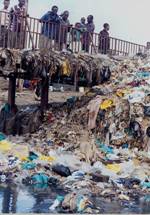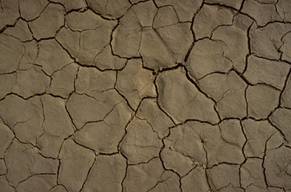- Deposition of solid waste
- Accumulation of non-biodegradable materials
- Toxification of chemicals into poisons
- Alteration of soil chemical composition (imbalance of chemical equilibrium to soil medium)

By as much, land pollution of this has amass globally, everyday threatening the very foundation and mechanical support of every matter on earth. Statistically, it has been shown that:
- loss of 6 million hectares of land per year
- loss of 24 billion tons of topsoil per year
- loss of minimum 15 million acres prime agricultural land to overuse and mismanagement
- desertification of land results in the lost of 16 million per square miles of world's land surface
The causes for such devastation are generally due to 2 (two) forms of malpractices:
- Unhealthy soil management methods;
- Improper tillage of soil in which excessive tillage result in the deterioration of soil structure
- Non-maintenance of a proper supply of organic matter in the soil from the imbalance composition of the reserves of organic matter especially nitrogen, phosphorus and sulfur unplenished supply after cultivation of vegetation, living the soil prone to soil infertility, unable to stabilize the soil physicality which ultimately let to desertification
- Irregular maintenance of a proper nutrient supply of trace elements gives rise to the use of excessive synthetic fertilizers, which are non biodegradable and accumulate in the soil system which eventually destroys useful organisms such as bacteria, fungi and other organisms
- Improper maintenance of the correct soil acidity which ultimately disrupt the adaptation of various crops and native vegetation of different soils as the solubility of minerals present will be affected. In a more acidic soil, minerals tend to be more soluble and washed away during rainfall while alkaline soil, minerals are more insoluble which form complex minerals unable to be absorbed into the flora system physiological usage.
- Improper irrigation practices;
- Poorly drained soil result in salt deposits leading to high soil salinity that inhibit plant growth and may lead to crop failure
- Unirrigated land giving rise to stagnation of agriculture waste products which accumulates and increases land toxicity and also decreasing
- Irregular irrigation leads to decreasing moisturization of land for soil medium and replenishments of solvents for minerals.
Sources and Methods
We can classify major sources that lead to land pollution to the following categories:
- Agriculture
- Mining and quarrying
- Sewage sludge
- Dredged spoils
- Household
- Demolitions and constructions
- Industrial
Soil Pollution Effects on humans

Soil and Water Pollution
- Causes cancers including leukaemia
- Lead in soil is especially hazardous for young children causing developmental damage to the brain
- Mercury can increase the risk of kidney damage; cyclodienes can lead to liver toxicity
- Causes neuromuscular blockage as well as depression of the central nervous system
- Also causes headaches, nausea, fatigue, eye irritation and skin rash
Other notes:
- Contact with contaminated soil may be direct (from using parks, schools etc) or indirect (by inhaling soil contaminants which have vaporized)
- Soil pollution may also result from secondary contamination of water supplies and from deposition of air contaminants (for example, via acid rain)
- Contamination of crops grown in polluted soil brings up problems with food security
- Since it is closely linked to water pollution, many effects of soil contamination appear to be similar to the ones caused by water contamination
Effects of Soil Pollution on Animals
- Can alter metabolism of microorganisms and arthropods in a given soil environment; this may destroy some layers of the primary food chain, and thus have a negative effect on predator animal species
- Small life forms may consume harmful chemicals which may then be passed up the food chain to larger animals; this may lead to increased mortality rates and even animal extinction
Soil Pollution Effects on Trees and Plants
- May alter plant metabolism and reduce crop yields
- Trees and plants may absorb soil contaminants and pass them up the food chain
Salination of Soil
Increase in salt concentration of soil affects soil productivity and degrades its quality. Inadequate drainage especially in flood ravaged and well irrigated areas leads to accumulation of salt at the soil surface. During summer season salts from lower layers move up by capillary action and get aggravated on soil surface. In India intensive farming with poor drainage has increased soil salinity.
Total saline land in our country-6 million hectares. In Punjab, 6000-8000 hectares.
Nearly 1/6th of arid and semi-arid lands of the world have high salinity.
Some Soil Pollutants and Their Effects
They combine with Mg2+ of chlorophyll and hence inhibit photosynthesis, cause leaf abscission and of fruit. Maize is the sensitive indicator of fluoride pollution. In human beings mottling of teeth (fluorosis) is an indication of fluorination. Bone fluorosis results in weak bones, boat shaped posture and knocking of knee.
2. Nitrogen fertilization (nitrates + nitrite)
Toxic concentration in leaves and fruits enters into food chain. In alimentary canal, activity of bacteria changes nitrates into nitries. The latter entres blood and combine with haemoglobin to form met6-haemoglobin so oxygen transport is reduced. It give rise to disease called methanaemoglobinaemia. In infants it cause cyanosis (blue babies due to bluish tint of skin). Nitrate poisoning is fatal unless methylene blue is injected (in infants) while in adult it produces breathlessness.
3. Weedicides
They are usually metabolic inhibitors which stop photosynthesis and other metabolic activities killing the plant. Some causes death due to proliferation of phloem cells to block transport of organic food.
Pollution control
Air Sparging
- Decrease the level of volatile constituents in petroleum products that are absorbed to soil and dissolved into groundwater, which involves the injection of contaminant free-air into subsurface saturated zone, enabling a transition from a dissolved state to a vapor phase
- In combination with soil vapor extraction (SVE) which creates a negative pressure through a series of extraction wells to control the vapor plume migration
- Effective in decreasing levels of volatile organic compounds (VOC) which can either use vertical or horizontal sparge wells, depend on:
- vapor/dissolved phase partitioning of the constituents determines the equilibrium distribution of a constituent between the dissolved phase and the vapor phase
- Permeability of soil determines rate of air injection into the saturated zone
Low Temperature Thermal Desorption
- Ex situ technology which uses heat to split petroleum hydrocarbon from excavated soils through physical methods
- Effective in decreasing levels of petroleum products like gasoline, jet fuels, kerosene, diesel fuel, heating oils and lubricating oils
- Mechanism criterion: contaminated soils are excavated and transferred to stationary facilities; mobile units operate immediately on site
- Treatment modes:
- Rotary dryers
- Asphalt plant aggregate dryer
- Thermal screw
- Conveyor furnace
Soil Vapor Extraction (SVE)
- In situ technology in reducing the level of volatile constituents in petroleum products absorbed to soil in the unsaturated (Vadose) in which vacuum are introduced to wells near the source of pollution, where the evaporated vapors are drawn to the extraction well to be treated by carbon absorption before being released to atmosphere
- Effective in use of volatile organic compounds (VOC) & certain semi volatile organic co
- Efficiency of SVE is determined by:
- Permeability of soil
- Soil structure and stratification
- Soil moisture
- Depth to groundwater
Soil Washing
- Elimination of hazardous waste and decrease the concentration to a minimum, which split the contaminated fine soil (silt and clay) from the coarse soil (sand and gravel)
- Upon completion, majority of fine silt and clay particles are further treated by bioremediation, incineration or disposed
- Effective with low presence of silt and clay, metals, gasoline, pesticide and fuel soils, with combinations of other treatment technology
- Important treatment mode is the soil scrubbing unit.
Agriculture measures to Control of Soil Pollution
1. Use of pesticides should be minimized.
2. Use of fertilizers should be judicious.
3. Cropping techniques should be improved to prevent growth of weeds.
4. Special pits should be selected for dumping wastes.
5. Controlled grazing and forest management.
6. Wind breaks and wind shield in areas exposed to wind erosion
7. Planning of soil binding grasses along banks and slopes prone to rapid erosion.
8. Afforestation and reforestation.



